Choosing the right cryptocurrency exchange can be a game-changer for your digital asset journey. When comparing two major platforms like Binance and Crypto.com, understanding their key differences helps you make an informed decision that aligns with your specific needs.
Binance offers lower fees, more trading pairs, higher volume, and advanced trading options, while Crypto.com provides a more user-friendly experience with its popular card program. Both platforms have their strengths – Binance processes withdrawals faster and supports more fiat currencies, whereas Crypto.com receives higher overall scores in comparison reviews.
Your trading style, preferred features, and priorities will ultimately determine which exchange works best for you. Whether you value Binance’s extensive trading options or appreciate Crypto.com’s simpler interface and card benefits, each platform offers unique advantages worth considering before you commit.
Binance vs Crypto.com: At A Glance Comparison
When choosing between Binance and Crypto.com, several key differences stand out. Here’s what you need to know about these popular crypto exchanges:
Available Cryptocurrencies:
- Binance: 600+ cryptocurrencies
- Crypto.com: Approximately 250 cryptocurrencies
Overall Rating (Based on BitDegree):
- Crypto.com: 9.4/10
- Binance: Slightly lower overall score
Fee Structure:
| Feature | Binance | Crypto.com |
|---|---|---|
| Credit/Debit Withdrawals | Available with 2% fee | Not available |
| Fiat Withdrawals | Multiple options | Bank wire only |
Binance offers more trading options with its extensive cryptocurrency selection. This makes it appealing if you’re interested in trading lesser-known altcoins.
Crypto.com provides a more streamlined experience but with fewer cryptocurrency choices. Their app is user-friendly for beginners.
Both platforms offer mobile apps, but their interfaces and user experiences differ significantly. Crypto.com often receives praise for its intuitive design.
For US-based traders, note that Binance.US (the American version) has different features than the international Binance platform. Crypto.com adjusts its offerings based on your region as well.
Trading fees vary between the platforms, with both offering ways to reduce costs through volume trading or holding their native tokens.
Binance vs Crypto.com: Trading Markets, Products & Leverage Offered
Binance offers a more extensive range of cryptocurrencies with over 800 deposit methods, while Crypto.com supports approximately 75. This difference makes Binance potentially more appealing if you’re looking for variety in your trading options.
Product Offerings:
- Binance: Trading, staking, NFT marketplace, futures, margin trading
- Crypto.com: Trading, staking, NFT marketplace, credit cards, payment services
Binance stands out with its leverage trading capabilities. You can access higher leverage levels on Binance compared to many competitors, which might attract you if you’re an experienced trader looking to amplify potential returns.
Trading Markets Comparison:
| Feature | Binance | Crypto.com |
|---|---|---|
| Market Share | Larger | Smaller |
| Cryptocurrencies | 800+ | 250+ |
| Trading Pairs | More extensive | More limited |
| Fiat Currencies | Multiple options | Fewer options |
Both platforms host NFT marketplaces, giving you options to trade digital collectibles. Crypto.com differentiates itself with stronger payment integrations, including crypto-based credit cards.
For withdrawals, Binance allows credit/debit card options with a 2% fee. Crypto.com processes fiat withdrawals only through bank wires, which may incur additional charges depending on your bank.
If trading volume matters to you, Binance has a significantly larger market share in both volume and trade count.
Binance vs Crypto.com: Supported Cryptocurrencies
When choosing between Binance and Crypto.com, the number of supported cryptocurrencies is an important factor to consider. Each platform offers different options for your trading needs.
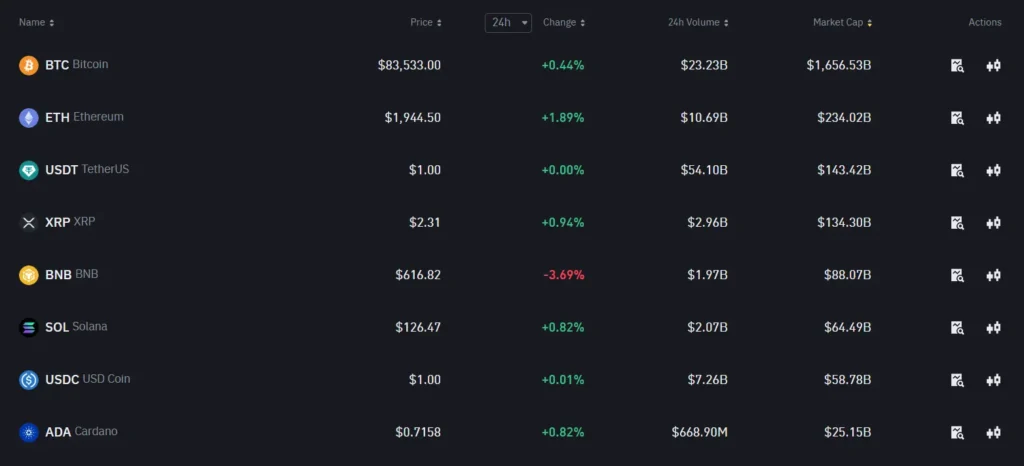
Binance stands out with an impressive selection of over 800 cryptocurrencies. This extensive range gives you more flexibility and trading possibilities, especially if you’re interested in lesser-known altcoins.
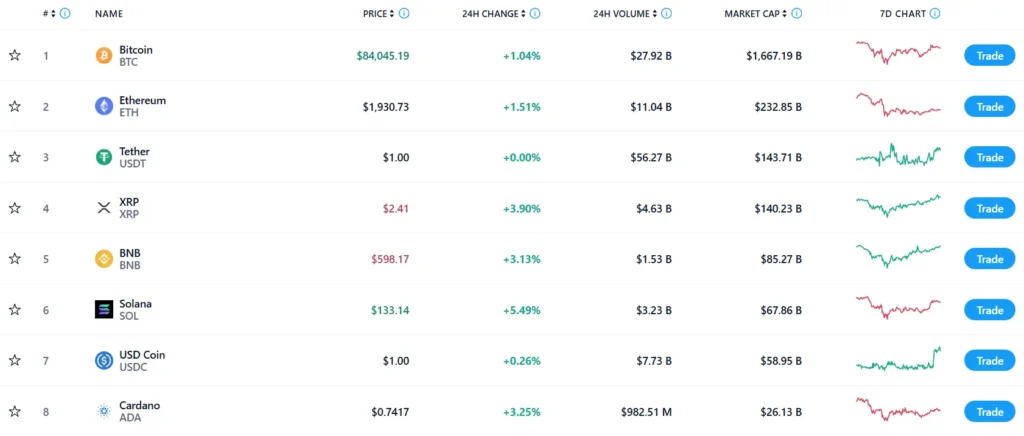
Crypto.com, contrary to some search results, actually supports over 75 cryptocurrencies. While this is significantly fewer than Binance, it still covers most major coins that many traders regularly use.
Comparison at a glance:
| Feature | Binance | Crypto.com |
|---|---|---|
| Number of cryptocurrencies | 800+ | 75+ |
| Major coins (BTC, ETH, etc.) | ✅ | ✅ |
| Altcoin variety | Extensive | Limited |
| Token selection | Wider range | Focused selection |
If you’re looking to trade niche cryptocurrencies or want the widest possible selection, Binance might be your better option. The platform continues to add new tokens regularly, giving you access to emerging projects.
Crypto.com focuses on quality over quantity, offering the most established cryptocurrencies. This approach makes it simpler for beginners who might feel overwhelmed by too many choices.
Your choice ultimately depends on which specific cryptocurrencies you want to trade and how important variety is to your investment strategy.
Binance vs Crypto.com: Trading Fee & Deposit/Withdrawal Fee Compared
When choosing between Binance and Crypto.com, understanding their fee structures can help you make the right decision for your trading needs.
Trading Fees
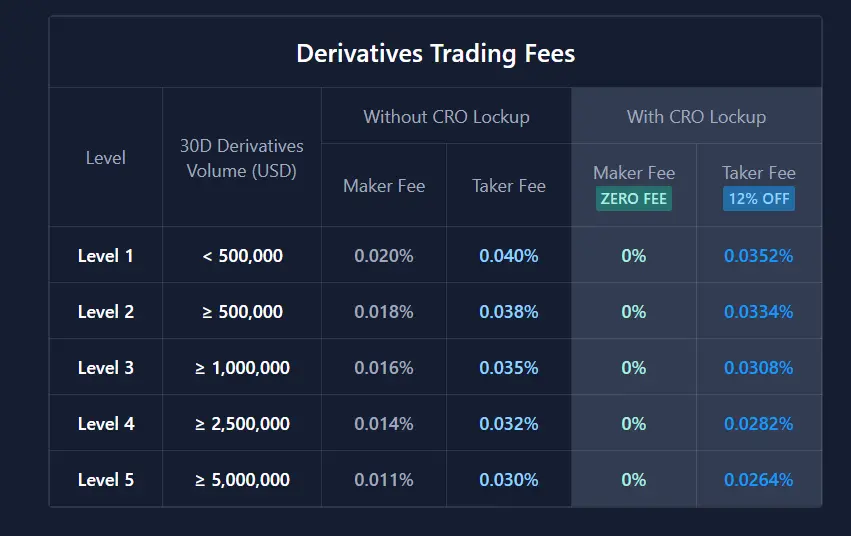
Crypto.com offers slightly lower trading fees with rates up to 0.3%, while Binance’s fees are competitive but typically a bit higher for most users.
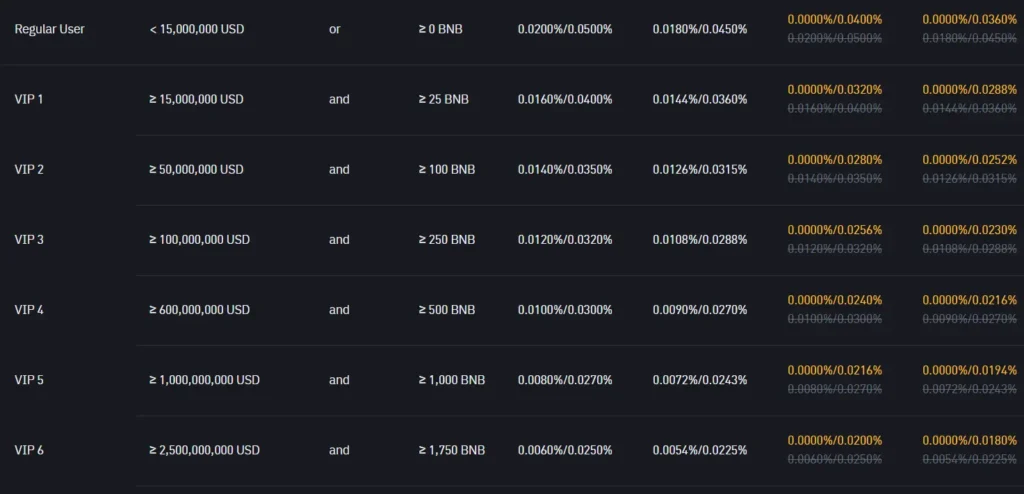
Both platforms offer fee discounts for high-volume traders and those who hold their native tokens (BNB for Binance, CRO for Crypto.com).
Deposit Fees
Most cryptocurrency deposits are free on both platforms, making it easy to fund your account without extra costs.
Withdrawal Fees
Binance allows credit/debit card withdrawals but charges a 2% fee for this convenience.
Crypto.com processes fiat withdrawals only via bank wire transfers, which often come with their own fees.
Cryptocurrency withdrawal fees vary by asset on both platforms, with Binance often having a wider range of withdrawal options.
Fee Comparison Table
| Fee Type | Binance | Crypto.com |
|---|---|---|
| Trading | Competitive | Up to 0.3% (lower) |
| Crypto Deposits | Mostly free | Mostly free |
| Fiat Withdrawals | 2% (card) | Bank wire only |
| Fee Discounts | Yes (with BNB) | Yes (with CRO) |
You should consider your trading volume and preferred withdrawal methods when comparing these platforms, as the best choice depends on your specific needs.
Binance vs Crypto.com: Order Types
When trading on cryptocurrency exchanges, the types of orders available can significantly impact your trading strategy. Both Binance and Crypto.com offer a variety of order types to help you execute trades effectively.
Binance Order Types:
- Market orders
- Limit orders
- Stop-limit orders
- One-Cancels-the-Other (OCO) orders
- Trailing stop orders
- Post-only orders
Binance provides more advanced trading options, making it suitable for both beginners and experienced traders. The platform’s trailing stop feature is particularly useful for maximizing profits in volatile markets.
Crypto.com Order Types:
- Market orders
- Limit orders
- Stop-loss orders
- Stop-limit orders
Crypto.com offers fewer order types compared to Binance, focusing on the most essential options for typical traders. While this means less complexity, it may limit advanced trading strategies.
For beginners, both platforms provide the necessary market and limit orders to get started. However, if you’re looking to implement more sophisticated trading strategies, Binance’s wider range of order types gives you more flexibility.
The user interface for placing orders is intuitive on both platforms, with Crypto.com having a slightly more streamlined approach that newer traders might find easier to navigate.
Binance vs Crypto.com: KYC Requirements & KYC Limits
Both Binance and Crypto.com require KYC (Know Your Customer) verification to comply with regulations. These checks help prevent fraud and ensure the platforms meet legal standards.
Binance KYC Process:
- Basic verification requires your name, date of birth, country of residence, and nationality
- Advanced verification needs government ID and facial recognition
- Verification unlocks higher trading limits and full platform features
Binance’s KYC process is thorough but straightforward. Most users can complete basic verification quickly, though some report longer wait times for advanced verification.
Crypto.com KYC Process:
- Similar requirements including personal information and ID verification
- Users often experience longer verification times compared to Binance
- Multiple verification tiers with increasing deposit and withdrawal limits
Crypto.com’s verification can sometimes take longer to process. This might be frustrating if you want to start trading right away.
KYC Limits Comparison:
| Platform | Basic Verification | Full Verification |
|---|---|---|
| Binance | Limited withdrawals | Up to 100+ BTC daily |
| Crypto.com | Basic trading only | Higher withdrawal limits |
Without KYC, your access to features on both platforms will be severely limited. You’ll need to complete at least basic verification to use core functions.
Both platforms store your verification data securely, but you should always use strong passwords and two-factor authentication for extra protection.
Binance vs Crypto.com: Deposits & Withdrawal Options
When choosing between Binance and Crypto.com, deposit and withdrawal options are key factors to consider.
Binance supports multiple deposit methods including bank transfers, credit/debit cards, and P2P trading. You can easily move funds onto the platform through these various channels.
Crypto.com also offers bank transfers and card payments, but their selection might be more limited depending on your region.
For withdrawals, Binance allows credit/debit card withdrawals with a 2.00% fee according to recent data. This gives you flexibility when cashing out your crypto assets.
Crypto.com processes fiat withdrawals primarily via bank wire transfers. These transfers may come with their own fees depending on your bank.
Fee comparison:
| Method | Binance | Crypto.com |
|---|---|---|
| Card Withdrawals | 2.00% fee | Not available |
| Bank Transfers | Varies by region | Available |
| Crypto Withdrawals | Network fee + small platform fee | Network fee + platform fee |
Both platforms support withdrawing a wide range of cryptocurrencies directly to your wallet. You’ll pay the network fee plus a small platform fee in most cases.
Processing times vary between the two exchanges. Bank transfers typically take 1-3 business days on both platforms, while crypto withdrawals are processed based on network congestion.
Each platform has different minimum and maximum deposit/withdrawal limits. These limits may be affected by your verification level and account status.
Binance vs Crypto.com: Trading & Platform Experience Comparison
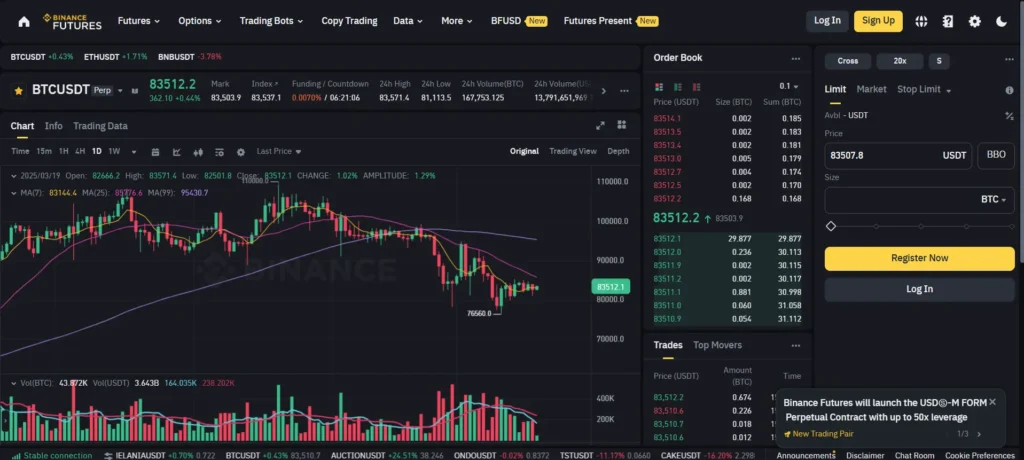
When choosing between Binance and Crypto.com, the trading experience differs significantly. Binance offers a more sophisticated trading interface with advanced tools that experienced traders might prefer.
Crypto.com provides a smoother, more user-friendly experience that beginners will find easier to navigate. The search results clearly indicate that Crypto.com has a better user experience compared to Binance.
For trading options, Binance takes the lead with a wider range of cryptocurrencies available. You’ll find more trading pairs and investment opportunities on Binance than on Crypto.com.
Fee Comparison:
| Platform | Trading Fees | Notes |
|---|---|---|
| Binance | Lower | Much cheaper according to user feedback |
| Crypto.com | Higher | Simpler fee structure |
When it comes to depositing and withdrawing funds, both platforms offer multiple options. Binance and Crypto.com both have on/off ramps for converting fiat to crypto.
Binance holds a larger market share in both trading volume and count. This might mean better liquidity when you’re trading popular cryptocurrencies.
If you’re new to crypto trading, Crypto.com’s interface might be less intimidating. Experienced traders, however, might appreciate Binance’s depth of features and lower fees.
Remember that Crypto.com has two different platforms – the main app and Crypto.com Exchange – which offer different experiences and fee structures.
Binance vs Crypto.com: Liquidation Mechanism
When trading with leverage on crypto exchanges, understanding liquidation is crucial. Liquidation happens when your margin balance falls below the required maintenance margin.
Binance has a clear liquidation process for futures trading. If your position’s losses cause your margin to drop too low, Binance will liquidate your position to prevent further losses. This helps protect both you and the platform from excessive risk.
Crypto.com also implements liquidation mechanisms, though they operate with slightly different parameters than Binance.
Key Differences:
-
Market Share: Binance has a larger trading volume, which can mean more liquidity during volatile markets when liquidations often occur.
-
Trading Experience: Binance offers a more sophisticated trading interface that includes detailed liquidation price indicators.
Both platforms will notify you when your position approaches liquidation levels. However, you should regularly monitor your positions, especially in volatile market conditions.
How to Avoid Liquidation:
- Keep sufficient funds in your account
- Use stop-loss orders to manage risk
- Avoid excessive leverage
- Monitor market conditions regularly
When choosing between these platforms, consider which liquidation mechanism feels more comfortable for your trading style. Binance might suit experienced traders with its detailed interface, while Crypto.com might appeal to those looking for a more straightforward experience.
Binance vs Crypto.com: Insurance
When looking for a crypto exchange, insurance can be an important safety factor to consider. Both Binance and Crypto.com offer some form of insurance protection, but there are differences in their approaches.
Binance maintains a Secure Asset Fund for Users (SAFU), which works as an emergency insurance fund. This fund holds 10% of all trading fees and can be used to cover losses in extreme cases of security breaches.
Crypto.com also prioritizes security through its insurance coverage. They maintain a $750 million insurance policy for their custodial assets, protecting users against theft or security issues.
Here’s a comparison of their insurance features:
| Feature | Binance | Crypto.com |
|---|---|---|
| Insurance Type | SAFU emergency fund | Custodial insurance policy |
| Coverage Amount | Variable (from trading fees) | $750 million |
| What’s Covered | Potential hack-related losses | Cold storage assets |
Neither exchange guarantees complete protection for all possible scenarios. Your funds could still be at risk during major market events or in certain security situations.
It’s worth noting that insurance typically covers institutional custody solutions rather than individual accounts. Always enable all security features like two-factor authentication to add extra protection to your accounts.
For maximum security, consider moving your crypto to a private wallet when you’re not actively trading. This gives you full control over your assets.
Binance vs Crypto.com: Customer Support
When choosing between Binance and Crypto.com, customer support quality can significantly impact your trading experience.
Based on user feedback, Crypto.com appears to have more responsive customer service. One user on Reddit specifically mentioned that “binance customer service could be 5x better,” clearly favoring Crypto.com’s support system.
Both platforms offer multiple ways to get help:
| Support Channel | Binance | Crypto.com |
|---|---|---|
| Live Chat | ✓ | ✓ |
| Email Support | ✓ | ✓ |
| Help Center | ✓ | ✓ |
| Social Media | ✓ | ✓ |
Response times can vary between the platforms. Crypto.com typically resolves issues more quickly, especially for basic account questions and verification issues.
Binance’s larger user base sometimes leads to slower response times, particularly during market volatility or high-volume trading periods. However, they offer more extensive documentation in their help center.
For complex issues, both exchanges might take longer to respond. Your experience may vary depending on your region, as support quality isn’t uniform across all countries.
If you’re new to crypto trading, Crypto.com’s more intuitive support system might be better suited to your needs. Their support team seems more accessible for beginners with basic questions.
Binance vs Crypto.com: Security Features
Both Binance and Crypto.com take security seriously to protect your crypto assets. Understanding the security measures each platform offers can help you make a more informed choice.
Crypto.com has a strong security track record with comprehensive measures in place. The platform uses cold storage for most user funds, multi-factor authentication, and has received several security certifications.
Binance implements similar security protocols, including two-factor authentication and advanced encryption. However, Binance experienced a major hack in 2019, which affected its reputation despite their quick response and full reimbursement to affected users.
Key Security Features Comparison:
| Feature | Binance | Crypto.com |
|---|---|---|
| Two-Factor Authentication | ✅ | ✅ |
| Cold Storage | ✅ | ✅ (Majority of funds) |
| Insurance Fund | ✅ (SAFU Fund) | ✅ ($750M coverage) |
| Regulatory Compliance | Varies by region | Strong compliance framework |
| Security Certifications | Multiple | ISO/IEC 27001:2013, PCI DSS |
When you use Binance, you can enable withdrawal whitelisting, which adds an extra layer of protection against unauthorized transfers. This feature requires you to pre-approve addresses before sending funds.
Crypto.com offers a unique security feature called “Defense in Depth” which creates multiple security layers to protect your assets. They also conduct regular security audits and penetration testing.
Both platforms monitor transactions 24/7 for suspicious activity and have dedicated security teams to respond to potential threats.
Is Binance A Safe & Legal To Use?
Binance is generally considered a safe platform for cryptocurrency trading. The exchange stores most of its cryptocurrency in “cold wallets” disconnected from the internet, which adds significant security.
For U.S. residents, Binance.US operates as a regulated alternative to the international platform. This version offers fewer cryptocurrencies and different fee structures but maintains proper security measures.
Binance implements several security features to protect your assets:
- Two-factor authentication (2FA)
- Anti-phishing codes
- Address whitelisting
- Device management
The platform has faced some regulatory challenges in different countries. These issues mainly relate to compliance with local laws rather than the security of the platform itself.
When comparing safety between Binance and Crypto.com, both exchanges prioritize security. According to search results, Crypto.com scores slightly higher overall with a 9.4 rating.
Binance offers some compelling advantages:
- Low trading fees
- Fee-free trading for many crypto pairs
- Large selection of cryptocurrencies
Before using Binance, check if it’s legal in your location. Regulations change frequently, and some countries have restrictions on cryptocurrency exchanges.
Remember to use strong passwords and enable all security features when setting up your account. Never share your private keys or security information with anyone.
Is Crypto.com A Safe & Legal To Use?
Crypto.com is generally considered a safe cryptocurrency exchange. According to search results, it’s “one of the safer crypto exchanges around” because it stores 100% of customer funds in cold wallets. This security measure helps protect your assets from online threats.
The platform is legitimate from a legal standpoint. It holds relevant licenses and complies with regulatory requirements in many jurisdictions. This means you can use the service with confidence about its legal status.
When comparing safety features with other platforms, Crypto.com offers solid protection. While fees might be higher than some competitors, the exchange provides robust security for your investments.
For those simply holding and accumulating cryptocurrency, Crypto.com is a suitable option. The platform offers more features than some competitors like Coinbase, which might justify the higher fees for some users.
Key safety features:
- 100% of customer funds kept in cold storage
- Regulatory compliance in multiple regions
- Legitimate licensing
If you’re deciding between Crypto.com and other exchanges like Binance, safety should be a key consideration. Both platforms have strong security measures, but Crypto.com’s focus on cold storage gives you an extra layer of protection for your digital assets.
Frequently Asked Questions
Here are answers to common questions about Binance and Crypto.com based on their platform features, fees, cryptocurrency offerings, security, customer support, and staking programs.
What are the key differences between Binance and Crypto.com platforms?
Binance offers a more sophisticated trading experience with advanced features aimed at experienced traders. The platform supports over 800 deposit methods and has a larger market share in trading volume.
Crypto.com provides a more user-friendly interface that appeals to beginners while still offering substantial functionality. It supports about 75 deposit methods and has a strong focus on its Visa card program with cashback rewards.
Both platforms offer mobile apps, but Binance’s trading tools are generally considered more comprehensive for serious traders.
How do the fees between Binance and Crypto.com compare?
Binance charges significantly lower trading fees compared to Crypto.com. Standard trading fees on Binance start at 0.1% and can be reduced further when using BNB tokens.
Crypto.com’s fees are generally higher, starting at around 0.4% for most users. However, higher-tier users who stake CRO tokens can access reduced fees.
Withdrawal fees vary by cryptocurrency on both platforms, but Binance typically offers more competitive rates for most popular coins.
Which platform offers a wider range of cryptocurrencies, Binance or Crypto.com?
Binance supports a substantially larger selection of cryptocurrencies with over 350 coins available for trading. This makes it the clear winner for users looking for variety and access to less common altcoins.
Crypto.com offers fewer cryptocurrencies overall, but still provides access to most major coins and tokens. Their selection is sufficient for most average traders who focus on established cryptocurrencies.
Both platforms regularly add new cryptocurrencies, but Binance typically lists new coins faster and more frequently.
What are the security measures implemented by Binance and Crypto.com to protect users’ assets?
Both exchanges implement strong security practices including two-factor authentication (2FA), anti-phishing codes, and address whitelisting. They also maintain large insurance funds to protect against potential breaches.
Binance secures user funds through its SAFU (Secure Asset Fund for Users) program, which allocates a portion of trading fees to a secure fund.
Crypto.com holds ISO 27001:2013 certification and uses cold storage for the majority of user assets, with multi-signature technology requiring multiple approvals for withdrawals.
How does the customer support experience differ between Binance and Crypto.com?
Crypto.com typically receives better ratings for customer support responsiveness. Their support team can be reached through in-app chat, email, and social media channels.
Binance has faced criticism for slower response times, especially during high-volume periods. However, they offer a more extensive knowledge base and FAQ section.
Both platforms provide support in multiple languages, but response times can vary significantly depending on the complexity of your issue and current demand.
What are the benefits of the staking programs on Binance and Crypto.com?
Binance offers flexible staking options with competitive APY rates across many cryptocurrencies. Their Locked Staking and DeFi Staking programs allow you to earn passive income with varying lock-up periods.
Crypto.com’s staking program centers around their native CRO token, with higher stakes providing better card rewards, reduced fees, and higher interest rates on other crypto deposits.
Both platforms allow you to stake directly from your account without technical knowledge, making it accessible for beginners looking to earn passive income on their holdings.
Crypto.com vs Binance Conclusion: Why Not Use Both?
Both Binance and Crypto.com offer unique advantages that could benefit your crypto journey. Binance stands out with lower fees, more trading pairs, and higher trading volume. It’s particularly good if you’re an active trader looking for variety.
Crypto.com shines with its visa card offerings and user-friendly interface. Many users find it easier to navigate, especially if you’re new to cryptocurrency exchanges.
You don’t actually have to choose just one platform. Many crypto users maintain accounts on both exchanges to leverage their different strengths.
Consider using Binance for your active trading needs, taking advantage of its lower fees and extensive options. Then use Crypto.com for its visa card perks and simpler interface for everyday crypto activities.
Your strategy might look like this:
| Platform | Best Used For |
|---|---|
| Binance | Trading, lower fees, more options |
| Crypto.com | Visa card, staking, beginner-friendly interface |
The crypto market changes quickly, so having access to multiple platforms gives you flexibility. You can move your assets between exchanges based on which offers better rates or features for specific coins.
Remember to check the latest fee structures and available features, as both platforms regularly update their offerings.
